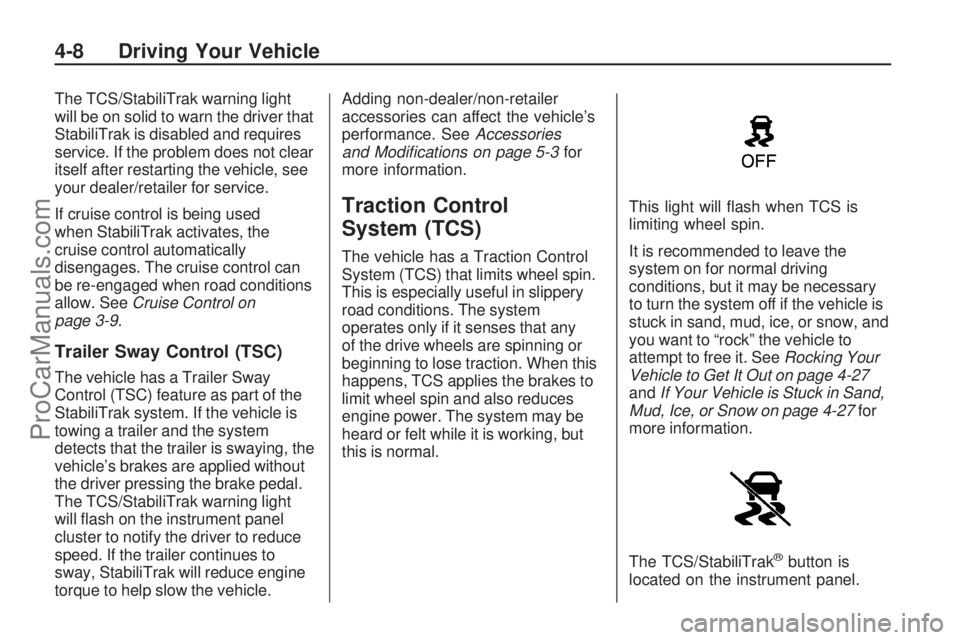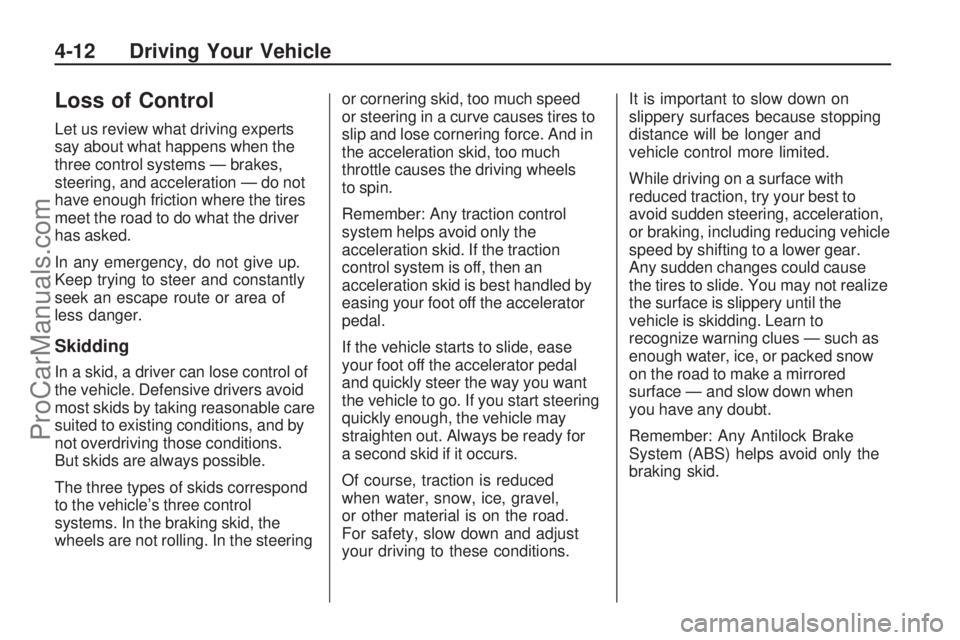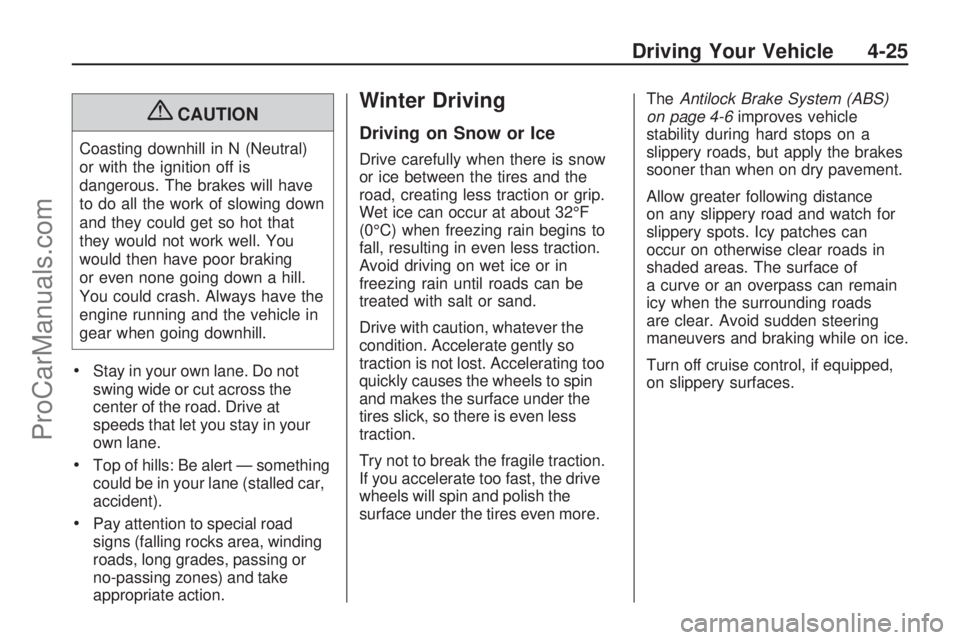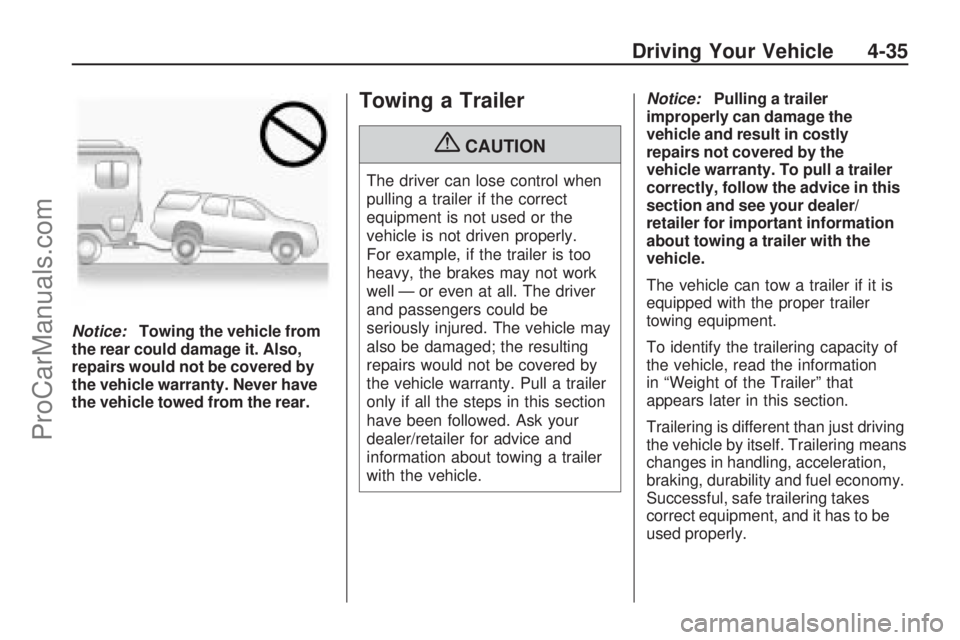brakes SATURN VUE 2009 User Guide
[x] Cancel search | Manufacturer: SATURN, Model Year: 2009, Model line: VUE, Model: SATURN VUE 2009Pages: 386, PDF Size: 2.3 MB
Page 212 of 386

The TCS/StabiliTrak warning light
will be on solid to warn the driver that
StabiliTrak is disabled and requires
service. If the problem does not clear
itself after restarting the vehicle, see
your dealer/retailer for service.
If cruise control is being used
when StabiliTrak activates, the
cruise control automatically
disengages. The cruise control can
be re-engaged when road conditions
allow. SeeCruise Control on
page 3-9.
Trailer Sway Control (TSC)
The vehicle has a Trailer Sway
Control (TSC) feature as part of the
StabiliTrak system. If the vehicle is
towing a trailer and the system
detects that the trailer is swaying, the
vehicle’s brakes are applied without
the driver pressing the brake pedal.
The TCS/StabiliTrak warning light
will �ash on the instrument panel
cluster to notify the driver to reduce
speed. If the trailer continues to
sway, StabiliTrak will reduce engine
torque to help slow the vehicle.Adding non-dealer/non-retailer
accessories can affect the vehicle’s
performance. SeeAccessories
and Modifications on page 5-3for
more information.
Traction Control
System (TCS)
The vehicle has a Traction Control
System (TCS) that limits wheel spin.
This is especially useful in slippery
road conditions. The system
operates only if it senses that any
of the drive wheels are spinning or
beginning to lose traction. When this
happens, TCS applies the brakes to
limit wheel spin and also reduces
engine power. The system may be
heard or felt while it is working, but
this is normal.This light will �ash when TCS is
limiting wheel spin.
It is recommended to leave the
system on for normal driving
conditions, but it may be necessary
to turn the system off if the vehicle is
stuck in sand, mud, ice, or snow, and
you want to “rock” the vehicle to
attempt to free it. SeeRocking Your
Vehicle to Get It Out on page 4-27
andIf Your Vehicle is Stuck in Sand,
Mud, Ice, or Snow on page 4-27for
more information.
The TCS/StabiliTrak
®button is
located on the instrument panel.
4-8 Driving Your Vehicle
ProCarManuals.com
Page 214 of 386

If you turn the steering wheel in
either direction several times until it
stops, or hold the steering wheel
in the stopped position for an
extended amount of time, you
may notice a reduced amount of
power steering assist. The normal
amount of power steering assist
should return shortly after a
few normal steering movements.
The electric power steering
system does not require regular
maintenance. If you suspect steering
system problems and/or the Service
Vehicle Soon light comes on, contact
your dealer/retailer for service
repairs.
Hydraulic Power Steering
If the vehicle has the hydraulic
power steering system and power
steering assist is lost because
the engine stops or the power
steering system is not functioning,
the vehicle can be steered but it
will take more effort.
Steering Tips
It is important to take curves at a
reasonable speed.
Traction in a curve depends on
the condition of the tires and
the road surface, the angle at which
the curve is banked, and vehicle
speed. While in a curve, speed
is the one factor that can be
controlled.
If there is a need to reduce speed,
do it before entering the curve,
while the front wheels are straight.
Try to adjust the speed so you
can drive through the curve.
Maintain a reasonable, steady
speed. Wait to accelerate until out
of the curve, and then accelerate
gently into the straightaway.
Steering in Emergencies
There are times when steering can
be more effective than braking. For
example, you come over a hill and
�nd a truck stopped in your lane, or a
car suddenly pulls out from nowhere,
or a child darts out from between
parked cars and stops right in front of
you. These problems can be avoided
by braking — if you can stop in time.
But sometimes you cannot stop in
time because there is no room.
That is the time for evasive
action — steering around the
problem.
The vehicle can perform very well
in emergencies like these. First
apply the brakes. SeeBraking on
page 4-5. It is better to remove as
much speed as possible from a
collision. Then steer around the
problem, to the left or right
depending on the space available.
4-10 Driving Your Vehicle
ProCarManuals.com
Page 216 of 386

Loss of Control
Let us review what driving experts
say about what happens when the
three control systems — brakes,
steering, and acceleration — do not
have enough friction where the tires
meet the road to do what the driver
has asked.
In any emergency, do not give up.
Keep trying to steer and constantly
seek an escape route or area of
less danger.
Skidding
In a skid, a driver can lose control of
the vehicle. Defensive drivers avoid
most skids by taking reasonable care
suited to existing conditions, and by
not overdriving those conditions.
But skids are always possible.
The three types of skids correspond
to the vehicle’s three control
systems. In the braking skid, the
wheels are not rolling. In the steeringor cornering skid, too much speed
or steering in a curve causes tires to
slip and lose cornering force. And in
the acceleration skid, too much
throttle causes the driving wheels
to spin.
Remember: Any traction control
system helps avoid only the
acceleration skid. If the traction
control system is off, then an
acceleration skid is best handled by
easing your foot off the accelerator
pedal.
If the vehicle starts to slide, ease
your foot off the accelerator pedal
and quickly steer the way you want
the vehicle to go. If you start steering
quickly enough, the vehicle may
straighten out. Always be ready for
a second skid if it occurs.
Of course, traction is reduced
when water, snow, ice, gravel,
or other material is on the road.
For safety, slow down and adjust
your driving to these conditions.It is important to slow down on
slippery surfaces because stopping
distance will be longer and
vehicle control more limited.
While driving on a surface with
reduced traction, try your best to
avoid sudden steering, acceleration,
or braking, including reducing vehicle
speed by shifting to a lower gear.
Any sudden changes could cause
the tires to slide. You may not realize
the surface is slippery until the
vehicle is skidding. Learn to
recognize warning clues — such as
enough water, ice, or packed snow
on the road to make a mirrored
surface — and slow down when
you have any doubt.
Remember: Any Antilock Brake
System (ABS) helps avoid only the
braking skid.
4-12 Driving Your Vehicle
ProCarManuals.com
Page 223 of 386

While backing down the hill, put
your left hand on the steering
wheel at the 12 o’clock position
so you can tell if the wheels are
straight and can maneuver as you
back down. It is best to back down
the hill with the wheels straight
rather than in the left or right
direction. Turning the wheel too
far to the left or right will increase
the possibility of a rollover.
Things not to do if the vehicle stalls,
or is about to stall, when going
up a hill:
Never attempt to prevent a stall
by shifting into N (Neutral) to
rev-up the engine and regain
forward momentum. This will
not work. The vehicle can
roll backward very quickly and
could go out of control.
Never try to turn around if about to
stall when going up a hill. If the hill
is steep enough to stall the
vehicle, it is steep enough to
cause it to roll over. If you cannot
make it up the hill, back straight
down the hill.If, after stalling, you try to back
down the hill and decide you just
cannot do it, set the parking brake,
put your transmission in P (Park),
and turn off the engine. Leave
the vehicle and go get some help.
Exit on the uphill side and stay clear
of the path the vehicle would take
if it rolled downhill.
Driving Downhill
When off-roading takes you
downhill, consider:
How steep is the downhill? Will I
be able to maintain vehicle
control?
What is the surface like? Smooth?
Rough? Slippery? Hard-packed
dirt? Gravel?
Are there hidden surface
obstacles? Ruts? Logs?
Boulders?
What is at the bottom of the hill?
Is there a hidden creek bank or
even a river bottom with large
rocks?If you decide you can go down a hill
safely, try to keep the vehicle headed
straight down. Use a low gear so
engine drag can help the brakes so
they do not have to do all the work.
Descend slowly, keeping the vehicle
under control at all times.
{CAUTION
Heavy braking when going down
a hill can cause your brakes to
overheat and fade. This could
cause loss of control and a
serious accident. Apply the brakes
lightly when descending a hill and
use a low gear to keep vehicle
speed under control.
Driving Your Vehicle 4-19
ProCarManuals.com
Page 224 of 386

Things not to do when driving down
a hill:
When driving downhill, avoid turns
that take you across the incline of
the hill. A hill that is not too steep
to drive down might be too steep
to drive across. The vehicle could
roll over.
Never go downhill with the
transmission in N (Neutral), called
free-wheeling. The brakes will
have to do all the work and could
overheat and fade.
Vehicles are much more likely to
stall when going uphill, but if it
happens when going downhill:
1. Stop the vehicle by applying the
regular brakes and apply the
parking brake.
2. Shift to P (Park) and, while still
braking, restart the engine.
3. Shift back to a low gear, release
the parking brake, and drive
straight down.
4. If the engine will not start, get
out and get help.
Driving Across an Incline
An off-road trail will probably go
across the incline of a hill. To decide
whether to try to drive across the
incline, consider the following:
{CAUTION
Driving across an incline that is
too steep will make your vehicle
roll over. You could be seriously
injured or killed. If you have any
doubt about the steepness of the
incline, do not drive across it. Find
another route instead.
A hill that can be driven straight
up or down might be too steep to
drive across. When going straight
up or down a hill, the length of the
wheel base — the distance from
the front wheels to the rear
wheels — reduces the likelihood
the vehicle will tumble end over
end. But when driving across
an incline, the narrower track
width — the distance between theleft and right wheels — might not
prevent the vehicle from tilting
and rolling over. Driving across an
incline puts more weight on the
downhill wheels which could
cause a downhill slide or a
rollover.
Surface conditions can be a
problem. Loose gravel, muddy
spots, or even wet grass can
cause the tires to slip sideways,
downhill. If the vehicle slips
sideways, it can hit something
that will trip it — a rock, a rut,
etc. — and roll over.
Hidden obstacles can make the
steepness of the incline even
worse. If you drive across a rock
with the uphill wheels, or if the
downhill wheels drop into a rut or
depression, the vehicle can tilt
even more.
For these reasons, carefully consider
whether to try to drive across an
incline. Just because the trail goes
across the incline does not mean you
have to drive it. The last vehicle to try
it might have rolled over.
4-20 Driving Your Vehicle
ProCarManuals.com
Page 226 of 386

Driving in Water
{CAUTION
Driving through rushing water can
be dangerous. Deep water can
sweep your vehicle downstream
and you and your passengers
could drown. If it is only shallow
water, it can still wash away the
ground from under your tires, and
you could lose traction and roll
the vehicle over. Do not drive
through rushing water.
Heavy rain can mean �ash �ooding,
and �ood waters demand extreme
caution.
Find out how deep the water is
before driving through it. Do not
try it if it is deep enough to cover
the wheel hubs, axles, or exhaust
pipe — you probably will not get
through. Deep water can damage
the axle and other vehicle parts.If the water is not too deep, drive
slowly through it. At faster speeds,
water splashes on the ignition
system and the vehicle can stall.
Stalling can also occur if you get the
tailpipe under water. If the tailpipe is
under water, you will never be able to
start the engine. When going through
water, remember that when the
brakes get wet, it might take longer to
stop. SeeDriving in Rain and on Wet
Roads on page 4-23.
After Off-Road Driving
Remove any brush or debris that
has collected on the underbody,
chassis, or under the hood. These
accumulations can be a �re hazard.
After operation in mud or sand,
have the brake linings cleaned and
checked. These substances can
cause glazing and uneven braking.
Check the body structure, steering,
suspension, wheels, tires, axles, and
exhaust system for damage and
check the fuel lines and cooling
system for any leakage.The vehicle requires more frequent
service due to off-road use.
Refer to the Maintenance Schedule
for additional information.
Driving at Night
Night driving is more dangerous than
day driving because some drivers
are likely to be impaired — by alcohol
or drugs, with night vision problems,
or by fatigue.
Night driving tips include:
Drive defensively.
Do not drink and drive.
Reduce headlamp glare by
adjusting the inside rearview
mirror.
Slow down and keep more space
between you and other vehicles
because headlamps can only
light up so much road ahead.
Watch for animals.
When tired, pull off the road.
Do not wear sunglasses.
4-22 Driving Your Vehicle
ProCarManuals.com
Page 227 of 386

Avoid staring directly into
approaching headlamps.
Keep the windshield and all glass
on your vehicle clean — inside
and out.
Keep your eyes moving,
especially during turns or curves.
No one can see as well at night as
in the daytime. But, as we get
older, these differences increase.
A 50-year-old driver might need
at least twice as much light to
see the same thing at night as
a 20-year-old.
Driving in Rain and on
Wet Roads
Rain and wet roads can reduce
vehicle traction and affect your
ability to stop and accelerate.
Always drive slower in these types
of driving conditions and avoid
driving through large puddles and
deep-standing or �owing water.
{CAUTION
Wet brakes can cause crashes.
They might not work as well in a
quick stop and could cause
pulling to one side. You could
lose control of the vehicle.
After driving through a large
puddle of water or a car/vehicle
wash, lightly apply the brake
pedal until the brakes work
normally.
Flowing or rushing water creates
strong forces. Driving through
�owing water could cause your
vehicle to be carried away. If this
happens, you and other vehicle
occupants could drown. Do not
ignore police warnings and be
very cautious about trying to drive
through �owing water.
Hydroplaning
Hydroplaning is dangerous. Water
can build up under your vehicle’s
tires so they actually ride on the
water. This can happen if the road is
wet enough and you are going fast
enough. When your vehicle is
hydroplaning, it has little or no
contact with the road.
There is no hard and fast rule about
hydroplaning. The best advice is
to slow down when the road is wet.
Other Rainy Weather Tips
Besides slowing down, other wet
weather driving tips include:
Allow extra following distance.
Pass with caution.
Keep windshield wiping
equipment in good shape.
Keep the windshield washer �uid
reservoir �lled.
Have good tires with proper tread
depth. SeeTires on page 5-43.
Turn off cruise control.
Driving Your Vehicle 4-23
ProCarManuals.com
Page 228 of 386

Before Leaving on a
Long Trip
To prepare your vehicle for a long
trip, consider having it serviced by
your dealer/retailer before departing.
Things to check on your own
include:
Windshield Washer Fluid:
Reservoir full? Windows
clean — inside and outside?
Wiper Blades:In good shape?
Fuel, Engine Oil, Other Fluids:All
levels checked?
Lamps:Do they all work and are
lenses clean?
Tires:Are treads good? Are tires
in�ated to recommended
pressure?
Weather and Maps:Safe to
travel? Have up-to-date maps?
Highway Hypnosis
Always be alert and pay attention
to your surroundings while driving.
If you become tired or sleepy, �nd
a safe place to park your vehicle
and rest.
Other driving tips include:
Keep the vehicle well ventilated.
Keep interior temperature cool.
Keep your eyes moving — scan
the road ahead and to the sides.
Check the rearview mirror and
vehicle instruments often.
Hill and Mountain Roads
Driving on steep hills or through
mountains is different than driving
on �at or rolling terrain. Tips for
driving in these conditions include:
Keep the vehicle serviced
and in good shape.
Check all �uid levels and brakes,
tires, cooling system, and
transmission.
Going down steep or long hills,
shift to a lower gear.
{CAUTION
If you do not shift down, the
brakes could get so hot that they
would not work well. You would
then have poor braking or even
none going down a hill. You could
crash. Shift down to let the engine
assist the brakes on a steep
downhill slope.
4-24 Driving Your Vehicle
ProCarManuals.com
Page 229 of 386

{CAUTION
Coasting downhill in N (Neutral)
or with the ignition off is
dangerous. The brakes will have
to do all the work of slowing down
and they could get so hot that
they would not work well. You
would then have poor braking
or even none going down a hill.
You could crash. Always have the
engine running and the vehicle in
gear when going downhill.
Stay in your own lane. Do not
swing wide or cut across the
center of the road. Drive at
speeds that let you stay in your
own lane.
Top of hills: Be alert — something
could be in your lane (stalled car,
accident).
Pay attention to special road
signs (falling rocks area, winding
roads, long grades, passing or
no-passing zones) and take
appropriate action.
Winter Driving
Driving on Snow or Ice
Drive carefully when there is snow
or ice between the tires and the
road, creating less traction or grip.
Wet ice can occur at about 32°F
(0°C) when freezing rain begins to
fall, resulting in even less traction.
Avoid driving on wet ice or in
freezing rain until roads can be
treated with salt or sand.
Drive with caution, whatever the
condition. Accelerate gently so
traction is not lost. Accelerating too
quickly causes the wheels to spin
and makes the surface under the
tires slick, so there is even less
traction.
Try not to break the fragile traction.
If you accelerate too fast, the drive
wheels will spin and polish the
surface under the tires even more.TheAntilock Brake System (ABS)
on page 4-6improves vehicle
stability during hard stops on a
slippery roads, but apply the brakes
sooner than when on dry pavement.
Allow greater following distance
on any slippery road and watch for
slippery spots. Icy patches can
occur on otherwise clear roads in
shaded areas. The surface of
a curve or an overpass can remain
icy when the surrounding roads
are clear. Avoid sudden steering
maneuvers and braking while on ice.
Turn off cruise control, if equipped,
on slippery surfaces.
Driving Your Vehicle 4-25
ProCarManuals.com
Page 239 of 386

Notice:Towing the vehicle from
the rear could damage it. Also,
repairs would not be covered by
the vehicle warranty. Never have
the vehicle towed from the rear.
Towing a Trailer
{CAUTION
The driver can lose control when
pulling a trailer if the correct
equipment is not used or the
vehicle is not driven properly.
For example, if the trailer is too
heavy, the brakes may not work
well — or even at all. The driver
and passengers could be
seriously injured. The vehicle may
also be damaged; the resulting
repairs would not be covered by
the vehicle warranty. Pull a trailer
only if all the steps in this section
have been followed. Ask your
dealer/retailer for advice and
information about towing a trailer
with the vehicle.Notice:Pulling a trailer
improperly can damage the
vehicle and result in costly
repairs not covered by the
vehicle warranty. To pull a trailer
correctly, follow the advice in this
section and see your dealer/
retailer for important information
about towing a trailer with the
vehicle.
The vehicle can tow a trailer if it is
equipped with the proper trailer
towing equipment.
To identify the trailering capacity of
the vehicle, read the information
in “Weight of the Trailer” that
appears later in this section.
Trailering is different than just driving
the vehicle by itself. Trailering means
changes in handling, acceleration,
braking, durability and fuel economy.
Successful, safe trailering takes
correct equipment, and it has to be
used properly.
Driving Your Vehicle 4-35
ProCarManuals.com